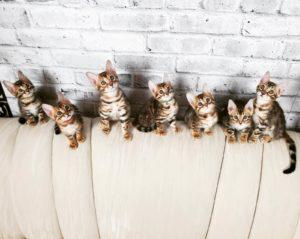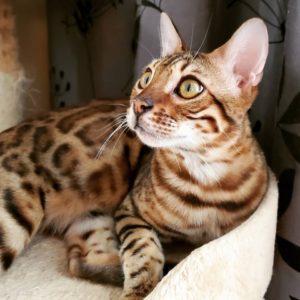TO LOVERS OF A LOW PRICES BENGALS!
BUY A KITTEN FOR $ 200 or $ 2000? WHY SUCH DIFFERENT PRICES?

People! I want to tell you that we do not come up with prices, but there is a price category of the breed – world! This is not just a cat, but an exotic and very 
A true breed Bengal can not cost $ 200-$500. It’s ridiculous to hear to tears: “I will buy your kitten for $ 500” or “Are there kittens below $ 1000?”Are you an expert to set the price? Kittens are evaluated exclusively by breeders and experts!
We will explain. The average price of a kitten of a Bengal cat breed ranges from $ 1500-2500 as a pet (after sterilization) in breeding, the price is double and higher! Well, a kitten cannot cost $ 500. Also in catteries, there are kittens – teenagers, unfortunately, are sold much cheaper, not because they are worse, but because the demand for adolescents is lower than for a small one.
The Bengal cat breed is one of the most expensive cats in the world! If you decide to swindle this breed, then please be kind to know the price category, if you can’t buy a kitten for $ 1500 then take a kitten from the shelter. We are breeders who work on the breed and invest a lot of money and effort. And we want our work to be evaluated as expected. The breeder is a job and very difficult 24/7/365 .I want to open your eyes – When you buy kitten from $ 250-800 that usely means your buying it from a “backyard cattery”. You need to be prepared for surprises and not always pleasant. There are cats are living in cages of 100 pieces wild and inadequate, not socially adapted (and kittens will also grow wild, no matter how you raise them), eat cheap food and do not know about cat tree and litter box. Such animals often start with health problems, they rarely live long, full lives cat. $1500-$2500 $ a breeder – who invests his whole soul, feeds premium food and meat, the cattery consists of 10 (or even less) producers who do not live in cages, all affectionate and social adapted.
Buying a kitten from a backyard catteries for $ 200-500 is a roulette, it will not survive. Such topics were, are and will be. I bought for $100 and for some reason the kitten died? Turned out to be sick. By posting your posts about a bad breeder, you blame everyone except yourself. And I will not say anything about the appearance of such kittens …
Do not buy at low price kitten! It will cost you either expensive treatment or tears!
Make the right choice!
Interesting facts about the Bengal cat


2. The picture of the surface of the cat’s nose is unique, like the fingerprint of a person.
3. Bengals almost never meow while communicating with each other. This sound is especially for people.
4. “Sociable” Bengal cats follow you from room to room to monitor your actions, her behavior is much like a dog! Bengals, are very curious animals and all the time looking for new games and activities, so do not leave them for a long time unattended. They will quickly teach you to close the drawers of cabinets 🙂 They like to hide, especially in boxes, nourish a secret passion for packs. A Bengal is a cat that always finds something to play with.
5. Bengal cats only have paw pads. Perhaps you noticed damp prints on the table after examination or veterinary examination, when they took the cat?
6. Giraffe, Camel and Cat are the only pacer animals, when walking they have first left legs, and then right ones. Such walking guarantees speed, agility and silence.
7. The cat’s ear turns 180 degrees. In each ear, Bengal cats have 32 muscles. To control the ear, they use twelve or more muscles.
8. How many years of your Bengal cat by human standards? If your cat is 3 years old, this corresponds to the human year 21. If 8 years, then humanly – 40. If 14, then 70 human years. The average life span of a domestic Bengal cat is 15 years, while for wildlife – from 3 to 5 years.
9. If the Bengal cat is near you, and her tail is shaking – this is the greatest feeling of love that it can express. When the tail begins to fall, then the mood has changed – you can move away, it will not be offended.
10.If the pupils of the cat are dilated, despite the bright illumination, the cat is very interested in something or in a playful mood. To the cats, enough to see 1 / 6th of the light necessary for a person. Their night vision is amazing! In the dark, the eyes of Bengal cats use even light reflected from the retina.
11. Cats, unlike dogs, can not focus their eyes on closely located objects, that is, long-sighted cats, and dogs are shortsighted. In fact, the best cat can see at a distance of 75 cm to 2-6 meters.
12.The sensitivity of the cat to the volume of sound is 3 times higher than that of a human! (If we listen to loud music or a TV thunders in the room, then we should let the cat go to another room!)
13. Bengal cats perceive audio frequencies in the range from 50 to 60 kHz. The dog reacts to a sound frequency of about 40 kHz. A person is able to pick up sounds at a frequency of 20 kHz.
14. The litter box should be in one place, so that the cat knows where the litter box is, and away from a bowl of food, because Bengal cats do not like to get dirty near the place where they eat.
15. Bengal cats love height. Also love the height of leopards and jaguars, who sleep in the trees.
16. If the Bengal cat falls, then its inner ear, which controls the balance, helps it to land on its paws.
17. When someone attacks a Bengal cat tightly presses the ears to the head. This is for protection from the teeth and claws of the enemy. If the Bengal cat attacks first, then it drops its ears horizontally and sideways, forming a triangle.
18. Bengal cats belong to the breeds of active cats. They study the actions of people, learn to open cabinets, doors and even windows. These cats are very smart, learn quickly and can master many tricks.
19. Bengal cats are similar in their behavior to small kittens – they never forget about games, even in old age. Hunters with an excellent response, they do not leave the slightest chance to save not only mice and rats, but even birds. Attacking any moving object, these cats can hunt your toes and fingers, and not only on specially purchased soft toys.
20. Well, the main feature is love of water, especially if it flows. Some only occasionally put their paw under the tap water, others will ask for a bath or frolic in the shower, as long as it’s their idea, of course. Some owners report that the charm of their Bengal cats is bordered by water on obsession.
21. This breed was bred by crossing a wild leopard cat with a domestic cat, so every Bengal kitten carries about 12-25% of the genes of the wild ancestor.
22. When we pet a cat, our heart rate and blood pressure decrease. And people with cardiovascular diseases have a chance to live longer if they have a cat, unlike those who have neither a cat nor a dog.